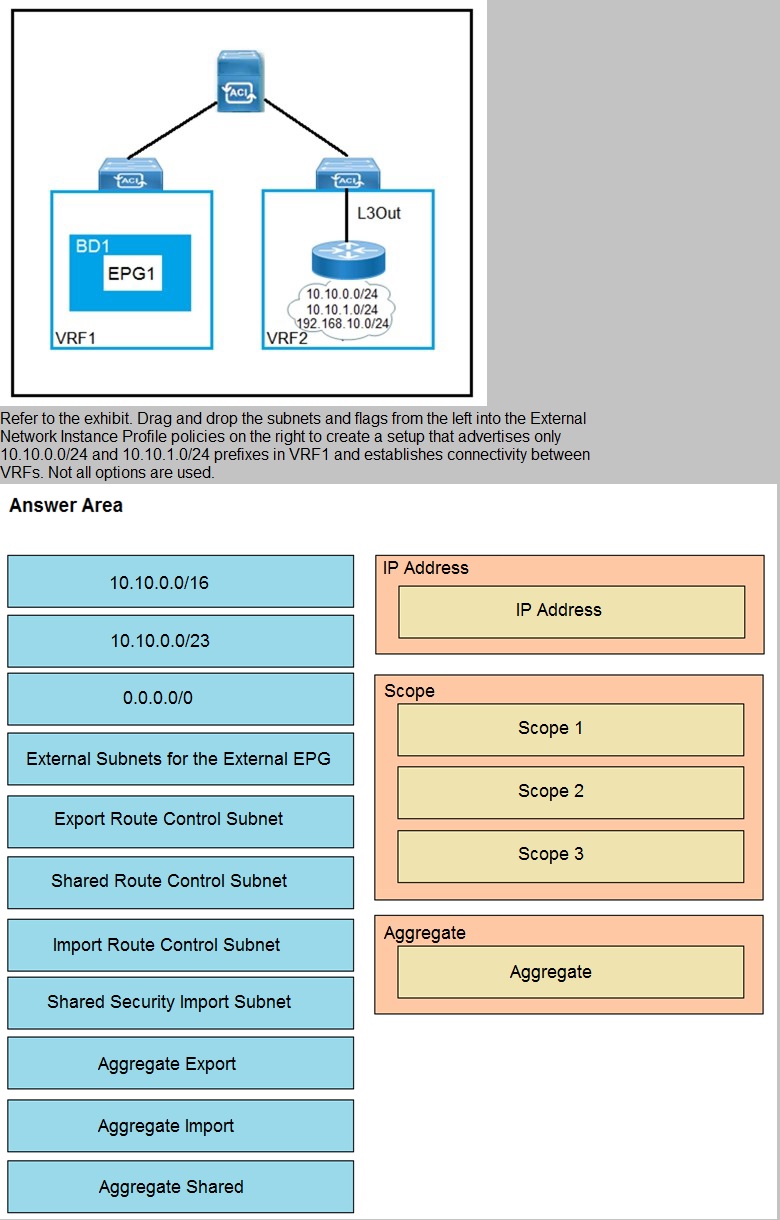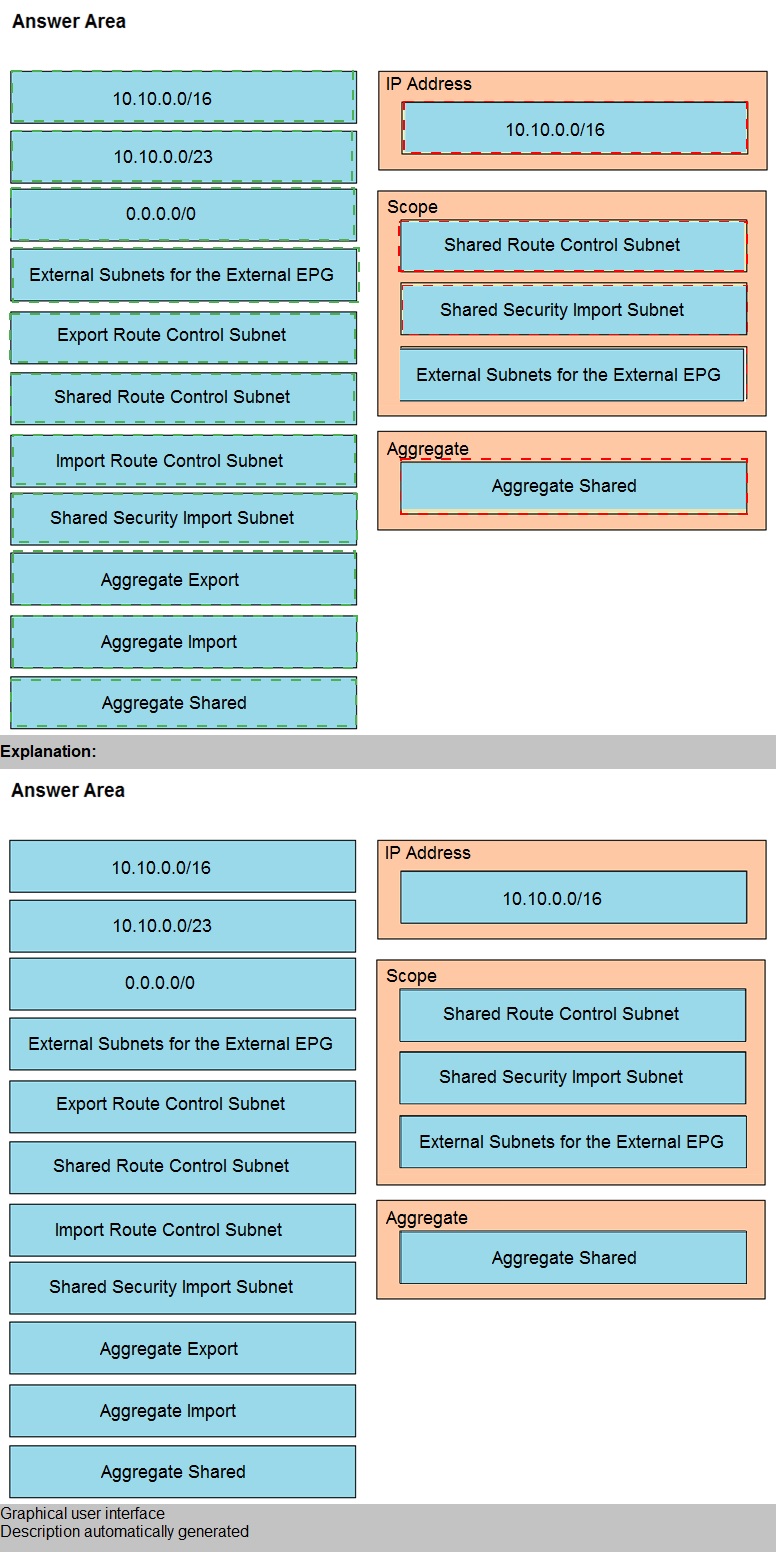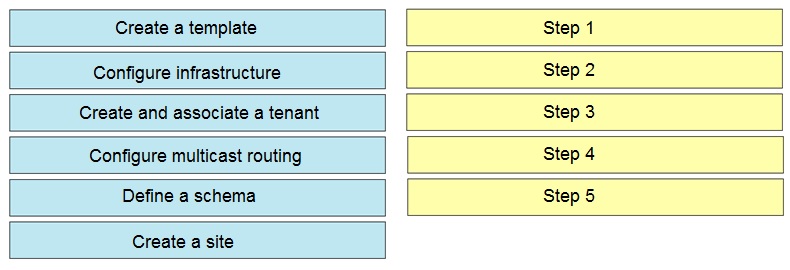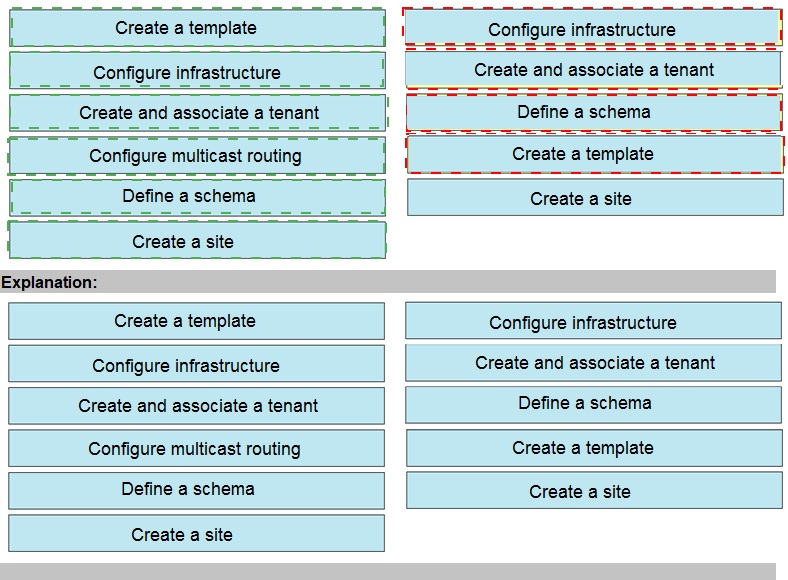What are two characteristics of Cisco ACI and Spanning Tree Protocol interaction? (Choose two.)
A.
When a TCN BPDU is received in a VLAN, Cisco ACI flushes the endpoints for the associated encapsulation.
B.
STP BPDUs are dropped due to MCP.
C.
MST BPDUs are flooded correctly in Cisco ACI fabric without additional configuration.
D.
BPDU filter and BPDU guard can be configured on Cisco ACI leaf edge ports.
E.
Cisco ACI must be configured as the STP root for all VLANs.
BPDU filter and BPDU guard can be configured on Cisco ACI leaf edge ports.
Cisco ACI must be configured as the STP root for all VLANs.
Reference:
https://www.cisco.com/c/en/us/td/docs/switches/datacenter/aci/aci_virtual_edge/configurati
on/1-x/
b_Virtual_Edge_Config_Guide_1_2_2/b_Virtual_Edge_Config_Guide_1_2_2_chapter_010
1.html
Refer to the exhibit.
How are the STP BPDUs forwarded over Cisco ACI fabric?
A.
STP BPDUs that are generated by Switch2 are received by Switch1 and Switch3.
B.
Cisco ACI fabric drops all STP BPDUs that are generated by the external switches.
C.
Cisco ACI acts as the STP root for all three external switches.
D.
STP BPDUs that are generated by Switch1 are received only by Switch3.
STP BPDUs that are generated by Switch2 are received by Switch1 and Switch3.
Reference: https://www.linkedin.com/pulse/cisco-aci-network-behaviour-stptcn-howidentify-
loop-ankit- kulshresta
An engineer creates the objects that must be deployed at each site in Cisco ACI Multi-Site Orchestrator. Which action should be taken before the schema can be associated with the newly configured site?
A.
Attach the templates to the newly configured site
B.
Configure a provider for the Cisco ACI Multi-Site Orchestrator
C.
Import existing policies from an existing tenant to Cisco ACI Multi-Site Orchestrator
D.
Configure the Infra Site-Specific Settings
Attach the templates to the newly configured site
Which two components must be configured as stretched to establish intra-VRF
communication between two EPGs that are deployed in different sites and different bridge domains? (Choose two.)
A.
contract
B.
tenant
C.
application profile
D.
bridge domain
E.
EPG
bridge domain
EPG
Reference: https://www.cisco.com/c/en/us/solutions/collateral/data-centervirtualization/
application-centric- infrastructure/white-paper-c11-739609.html
In a Cisco ACI Multi-Site fabric, the Inter-Site BUM Traffic Allow option is enabled in a specific stretched bridge domain. What is used to forward BUM traffic to all endpoints in the same broadcast domain?
A.
ingress replication on the spines in the source site
B.
egress replication on the source leaf switches
C.
egress replication on the destination leaf switches
D.
ingress replication on the spines in the destination site
ingress replication on the spines in the destination site


An engineer deploys a Cisco ACI Multi-Site Orchestrator for the first time. Drag and drop the actions from the left into the steps on the right to add a site and deploy new Cisco ACI objects to the fabric. Not all actions are used.


An engineer configures a Cisco ACI Multi-Pod for disaster recovery. Which action should
be taken for the new nodes to be discoverable by the existing Cisco APICs?
A.
Enable subinterfaces with dot1q tagging on all links between the IPN routers.
B.
Configure IGMPv3 on the interfaces of IPN routers that face the Cisco ACI spine.
C.
Enable DHCP relay on all links that are connected to Cisco ACI spines on IPN devices.
D.
Configure BGP as the underlay protocol in IPN.
Configure IGMPv3 on the interfaces of IPN routers that face the Cisco ACI spine.
An engineer implements the Cisco ACI solution and needs to confirm that the leaf switch
correctly learns the remote endpoint MAC. Which information must be included in the
VXLAN packet that is received from the Cisco ACI spine for the Cisco ACI leaf to learn
MAC as a remote endpoint?
A.
VRF
B.
application profile
C.
bridge domain
D.
EPG
bridge domain
Reference:
https://www.cisco.com/c/en/us/solutions/collateral/data-center-virtualization/applicationcentric-
infrastructure/ white-paper-c11-739989.html
As part of a newly deployed ACI fabric, a pair of border leaf switches have been deployed
to provide shared services for all tenants. The configured L3Out runs OSPF as the routing
protocol. The requirement is to advertise the routes from the border leaf switches to the
compute leaf switches. Which configuration must be implemented to meet these
requirements?
A.
Configure a BGP route reflector policy for the Cisco ACI pod
B.
Define the shared L3Out in the common tenant
C.
Enable Import Route Control Enforcement in the L3Out policy
D.
Define the consumer subnet under the consumer EPG
Configure a BGP route reflector policy for the Cisco ACI pod
Reference:
https://www.cisco.com/c/en/us/solutions/collateral/data-center-virtualization/applicationcentric-
infrastructure/ guide-c07-743150.html
Refer to the exhibit.
Which three actions should be taken to implement the vPC in the Cisco ACI fabric? (Choose three.)
A.
Select a common vPC interface policy group
B.
Select individual interface profiles
C.
Select common interface profiles
D.
Select individual switch profiles
E.
Select common switch profiles
Select a common vPC interface policy group
Select individual interface profiles
Select common switch profiles
Refer to the exhibit.
How is the ARP request from VM1 forwarded when VM2 is not learned in the Cisco ACI
fabric?
A.
Leaf 101 forwards the ARP request to one of the proxy VTEP spines.
B.
POD1 spine responds to the ARP request after the POD1 COOP is updated with the VM2 location.
C.
Leaf 101 encapsulates the ARP request into a multicast packet that is destined to 225.0.37.192.
D.
Leaf 101 switch consumes the ARP reply of VM2 to update the local endpoint table
Leaf 101 forwards the ARP request to one of the proxy VTEP spines.
| Page 2 out of 7 Pages |
| Previous |